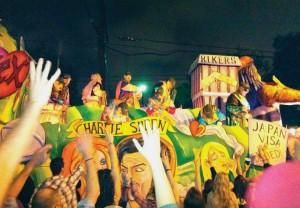No headline provided

February 16, 2012
Krewe of Bachus, Sunday 5:15 P.M.
Uptown
The Krewe of Bacchus is one of the largest and most famous parades of the Uptown route. Featuring 33 floats and more than 1,300 members, Bacchus revolutionized the way Mardi Gras is celebrated. The krewe was the brainchild of Owen Edward Brennan, founder of Brennan’s Restaurant, who wanted to open up Mardi Gras to tourists. The first Bacchus parades ran from 1949-50, and were revived by Brennan’s son in 1968. The parade broke tradition and was held on a Sunday and featured larger, more spectacular floats than ever before. The krewe is also led by a national celebrity, crowned King of Bacchus. This year’s king is Will Ferrell. Past kings include Drew Brees, Elijah Wood and Nicholas Cage.
The parade starts at 5 p.m. on Sunday on the corner of Napoleon Avenue and Tchoupitoulas streets, runs down St. Charles Avenue, through Lee Circle, down Canal Street and finishes at the New Orleans Convention Center. Signature floats include the Bacchasaurus, the Bacchagator, the Bacchawoppa and King Kong. The riders will throw footballs as well as the traditional beads, dubloons, cups and footballs. The parade Lieutenants will throw special black doubloons to a lucky few parade-goers. – Lucy Stratton
Krewe of Proteus, Monday 5:15 P.M.
Uptown
The Krewe of Proteus, founded in 1882, is the second oldest krewe of Carnival. Beginning as a strictly Creole krewe, it is named after The Old Prophetic Man of the Sea, a sea god who was the shepherd of the oceans and Poseidon’s seals. The parade takes place on Lundi Gras and follows the traditional Uptown parade route along St. Charles Avenue, ending up at Canal Street. The parade features a giant seashell float, which, like the majority of the Proteus floats, uses the same framework from the inaugural 1882 parade.
The Krewe of Proteus is known for creating the call-out tradition in 1893, in which male riders call out to women during the parade, asking them to dance. The Krewe of Proteus is also famous for its flambeaux carriers, young men with blazing torches that light the way for the parade. Almost every other krewe has adopted this tradition. Last year’s Carnival, Proteus featured more than 260 riders and 20 floats. The krewe’s throws are historically known for lacking in quality, though more recently have thrown cups, light-up beads, glass beads and 60-inch red-and-white bead necklaces. – Halle Kaplan-Allen
Krewe of Orpheus, Monday 6PM
Uptown
Founded in 1993 by Harry Connick Jr., his father and Sonny Borey, the Krewe of Orpheus is considered one of New Orleans’ “super krewes” because of its large membership. Orpheus is named after a figure in Greek mythology who has power over music in both this world and the afterlife. This year, the theme is Nonsense and Tomfoolery. Previous themes have included Delectable Delights and The Whimsical World of How and Why. Every year, the parade has several celebrity “monarchs” who are in charge of the proceedings. This year, these celebrities include Harry Connick Jr., Cyndi Lauper and Hilary Swank. The parade begins on Lundi Gras at 6 p.m., starts at Tchoupitoulas Street and Napolean Avenue, and ends at the New Orleans Convention Center. – Abby Watkins
Krewe of Zulu, Tuesday 8AM
Uptown
In early 1909, a group of laborers in a Benevolent Aid Society – a group in the black community where members could receive health insurance – went to the Pythian Theater to see a comedy about the legendary Zulu Tribe. These men created the Krewe of Zulu and made their first official Mardi Gras appearance that year. To this day, Zulu is one of the most celebrated krewes of Carnival. In the early 1900s, most other Mardi Gras krewes threw beads, which at the time were handmade from expensive glass. Because the men in the Krewe of Zulu could not afford to throw beads, they painted coconuts to pelt at parade-goers. Zulus are still known best for their Mardi Gras coconuts, as well as for their unique attire – members wear grass skirts and paint their faces black, a mockery of the regal and elaborate costumes of Rex. The Krewe of Zulu will parade bright and early at 8 a.m. Tuesday morning, making stops on St. Charles Avenue and Canal Street. – Jamie Norwood
Krewe of Rex, Tuesday 10A.M.
Uptown
Mardi Gras culminates on Monday morning with the Krewe of Rex Parade. Rex will lead his subjects at 10 a.m., beginning at the corner of South Clairborne and Napoleon avenues. It will continue down Napoleon before turning left onto St. Charles Avenue. The royal procession will then round Lee Circle, continue on St. Charles and complete its journey at the intersection of South Peters and Canal streets. The parade routinely boasts elaborate and colorful floats with themes from literature and mythology. Rex is one of the oldest Mardi Gras parades, as it started in 1872 while the city was recovering from the Civil War. In the early 1900s, Rex arrived on a boat on the Mississippi and docked downtown. Recently bankrupt planters and city aristocrats dressed as royalty and romanticized the antebellum south. Initially begun to impress Russia’s Grand Duke Alexis Romanoff, Rex Parade has become the climax of every Carnival parade season. The Krewe is responsible for the Mardi Gras colors of purple, green, and gold. This tradition cannot be missed. The Krewe of Rex Parade is the original day parade, so any Carnival celebration would be incomplete without it. Besides, your hangover will welcome the crisp morning air. Watch for flying dubloons, as Rex is known for distributing these among their bundles of beads. – Everett Phelps
Krewe d’Etat, Friday 6:30 P.M.
Uptown
The Krewe d’Etat will be rolling out its ‘Fat Friday’ parade at 6:30 p.m. on Feb. 17, beginning on the corner of Jefferson and Magazine streets, moving onto St. Charles Avenue for the majority of the parade and ending at the intersection of Canal and Camp streets. This year’s parade boasts the theme of Le Krewe d’Etat’s Wide Woild of Sports, an interesting choice for a parade that has often thrived on mockery of those in authority.
This Krewe is headed by an enigmatic figure known as The Dictator, who reigns over the parade alongside his court, comprised of the Kingfish, the Special Man, the Minister of Misinformation, the Keeper of Bones and the High Priest. D’Etat stands out from other parades due to the novelty of its prize throws: Chains of glow-in-the-dark beads attached to flashing green eyes. Krewe d’Etat has a bit of everything that makes Mardi Gras great: terrific free stuff, krewe members rich with equal measures of jubilance and complete weirdness, viciously subversive float themes and cranium-obliterating public inebriation. Don’t miss it. – Charles Bramesco
Krewe of Iris, Saturday 11 A.M.
Uptown
The Krewe of Iris-named after the goddess of the rainbow and the messenger of the gods-is the oldest and largest all-female krewe of Carnival. Though founded in 1917, Iris did not participate in its first Mardi Gras parade until 1959. The parade features more than 900 riders, as well as 32 floats, numerous equestrian units and marching bands. The riders adhere to the traditional Carnival dress of long white gloves and full-length masks. The parade takes place on Saturday and follows the traditional Uptown route along St. Charles Avenue, ending up along Canal Street in the French Quarter. Typical throws include emblem cups, medallion and ceramic Iris beads in chartreuse and lavender, dolls, and doubloons. The krewe captain has her own blue and silver collectible 10-gauge doubloons, one of the most coveted throws of Carnival. – Halle Kaplan-Allen
Krewe of Endymion, Saturday 4:15 P.M.
Mid-city
If for some unfathomable reason you make it to only one parade this Mardi Gras, that parade had better be Endymion. One of three “super-krewes,” Endymion is known for its celebrity Grand Marshals and generous throws, tossing so many beads, cups and the like that it’s been given the motto, “Throw ‘Til It Hurts!” Founded in 1967 for the Olympian god of fertility, the first parade was sports themed, featuring Tulane football coach Jim Pittman and a new football team that had yet to play its first game – The Saints.
Jump forward a few years and Endymion has made a huge impact on the Carnival season, popularizing the idea of presenting a krewe’s royalty and court, as well as a “pre-parade” of mini-floats. Even bigger than the parade, however, is the Endymion Extravaganza in the Superdome after the parade, one of the year’s biggest parties. Endymion will make its way through Mid-City starting at 4:15 p.m., but you should get there well in advance to stake out your spot. We recommend Lee Circle. With Maroon 5 as grand marshals, along with special guests Big and Rich, Gretchen Wilson, and silver fox Anderson Cooper, get ready for crazy crowds and a nonstop party. Be prepared to possibly not remember the fun time you had. – Stephanie Chen
Krewe of Morpheus, Friday 7 P.M.
Uptown
Morpheus was established in 2000 and is one of New Orleans’s newest and largest krewes, more than 400 members. Named for the Greek god of dreams, Morpheus aims to provide an experience more in line with the traditional parades. The theme for this year’s parade will be Louisiana Treasures. For those of you unfortunate enough to have Friday classes, book it down St. Charles after your last one and mark your spot early. Friday is a big Carnival night, with three major parades rolling in quick succession. The parade starts at 7 p.m. Friday and will span approximately five miles. – Abby Watkins
Krewe of Tucks, Saturday Noon
Uptown
The Krewe of Tucks’ motto – “Booze, Beer, Bourbon, Broads” – pretty much sums up the parade. Known for its mockery, the Krewe of Tucks was conceived in 1969 when a group of Loyola University students decided to create its own krewe after unsuccessfully attempting to become the first caucasian flambeaux carriers. The krewe is named after Friar Tuck’s, the late Freret Street pub once popular among Loyola students. The parade has grown immensely through the years. The Krewe of Tucks started as a small nighttime parade with floats on the back of pickup trucks.
Today, the Krewe of Tucks features floats of major proportions and is one of the most attended parades. The parade boasts satirical floats such as the famous “King’s Throne,” a giant toilet. The Krewe of Tucks will parade Uptown Saturday afternoon. Beginning on Napoleon Avenue, it will run down St. Charles Avenue and end on Canal Street. Afterwards, the Krewe of Tucks hosts a post-parade blowout open to the public: The Tucks Extravaganza, beginning at 3:30 p.m. at 555 Canal St. – Jamie Norwood
Krewe of Thoth, Sunday Noon
Uptown
The Krewe of Thoth was founded in 1947, honoring the Egyptian deity of science, wisdom, art and writing. The krewe was specifically created to provide those who were unable to attend the Downtown celebrations with a Mardi Gras parade, passing in front of 14 hospitals and institutions on its original route, including the Children’s Hospital. Thoth has more than 40 floats carrying more than 1,200 krewe members who will be throwing, among other things, metallic necklaces and stuffed polar bears. Thoth starts on State and Tchoupitoulas streets, turning onto Magazine. Most students can catch the parade from the usual Tulane hotspots along St. Charles as it heads downtown at the intersection of St. Charles and Napoleon avenues, or watch on Magazine street. The krewe follows St. Charles all the way down to Lee Circle, and it ends on Tchoupitoulas and Poydras street. Krewe of Thoth begins at noon. on Sunday, and known for its quirky themes and gorgeous floats, it is a great day parade you will not want to miss. – Abbie Levenson









Leave a Comment